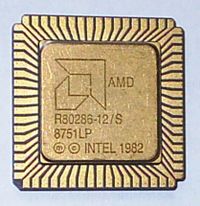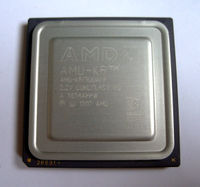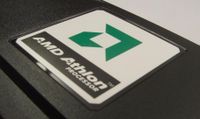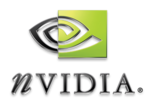|
AMD ADVANCED MICRO DEVICES INC.
|
|||||||||||||||||||
|
HOME | BIOLOGY | FILMS | GEOGRAPHY | HISTORY | INDEX | MUSIC | THE BOAT | SOLAR BOATS | SPONSORS |
|||||||||||||||||||
|
Advanced Micro Devices, Inc. (abbreviated AMD; NYSE: AMD) is a manufacturer of integrated circuits based in Sunnyvale, California. It is the second-largest supplier of x86-compatible processors, and a leading supplier of non-volatile flash memory. It was founded in 1969 by a group of defectors from Fairchild Semiconductor, including Jerry Sanders. AMD's current CEO is Dr. Héctor Ruiz. The current president and Chief Operating Officer is Dirk Meyer.
AMD is best known for the Athlon, Opteron, Turion 64, Sempron and Duron lines of x86-compatible processors.
AMD 8080 Processor (AMD AM9080ADC / C8080A), 1977
Financial information
AMD is publicly traded at NYSE with the symbol AMD. Its market capitalization was around US$13 billion at the end of 2005.
General history
The company started as a producer of logic chips in 1969, then entered the RAM chip business in 1975. That same year, it introduced a reverse-engineered clone of the Intel 8080 microprocessor. During this period, AMD also designed and produced a series of bit-slice processor elements (Am2900, Am29116, Am293xx) which were used in various minicomputer designs.
During this time, AMD attempted to embrace the perceived shift towards RISC with their own AMD 29K processor, and they attempted to diversify into graphics and audio devices as well as flash memory. While the AMD 29K survived as an embedded processor and AMD continues to make industry leading flash memory, AMD was not as successful with its other endeavors. AMD decided to switch gears and concentrate solely on Intel-compatible microprocessors and flash memory. This put them in direct competition with Intel for x86 compatible processors and their flash memory secondary markets.
AMD 80286 1982
8086, 80286, 80386, Am486
In February 1982, AMD signed a contract with Intel, becoming a licensed second-source manufacturer of 8086 and 8088 processors. IBM wanted to use the Intel 8088 in its IBM PC, but IBM's policy at the time was to require at least two sources for its chips. AMD later produced the 80286, or 286, under the same arrangement, but Intel cancelled the agreement in 1986, and refused to hand over technical details of the i386 part. The growing popularity of the PC clone market meant Intel could produce CPUs on its own terms, rather than IBM's.
AMD challenged this decision, and subsequently won under arbitration. A long legal dispute followed, ending in 1991 when the Supreme Court of California sided with AMD and forced Intel to pay over $1 billion in compensation for violation of contract. Subsequent legal disputes centered on whether AMD had legal rights to use derivatives of Intel's microcode. Rulings were made in both directions. In the face of uncertainty, AMD was forced to develop "clean room" versions of Intel code. In this fashion, one engineering team described the function of the code, and a second team without access to the source code itself had to develop microcode that performed the same functionality.
In 1991 AMD released the Am386, its clone of the later Intel 80386 processor. It took less than a year for AMD to sell a million units. AMD's 386DX-40 was very popular with smaller, independent clone manufacturers. AMD followed in 1993 with the Am486. Both sold at a significantly lower price than the Intel versions. The Am486 was used by a number of large OEMs, including Compaq, and proved popular, but again was just a clone of Intel's processor technology. But as product cycles shortened in the PC industry, cloning Intel's products became an ever less viable strategy for AMD, as it meant their technology would always be behind Intel.
On December 30, 1994 the Supreme Court of California finally formally denied AMD rights to use the i386's microcode. Afterwards AMD and Intel concluded an agreement, the details of which remain largely secret, which gave AMD the right to produce and sell microprocessors containing the microcodes of Intel 286, 386, and 486. The agreement appears to allow for full cross-licensing of patents and some copyrights, allowing each partner to use the other's technological innovations without charge. Whatever the details, no significant legal action had resulted between AMD and Intel (until the 2005 antitrust suits in Japan and the U.S.), and the agreement evidently provided a "clean break".
K5
AMD's first completely in-house processor was the K5, launched belatedly in 1995. The "K" was a reference to "Kryptonite" which from comic book lore was the only substance that could harm Superman (a clear reference to Intel which was dominant in the market).
It was intended to compete directly with the Intel Pentium CPU, which had been released in 1993, but architecturally it had more in common with the newly-released Pentium Pro than the Pentium or Cyrix's 6x86, decoding x86 instructions into micro-ops and executing them on a RISC core. There were a number of problems. Many consumers were upset to learn the clock speed of their processor did not match the PR rating used to label some of the parts, and this was especially obvious at boot time, when the clock speed was posted to the main screen on many systems.
More tellingly, the K5 couldn't match the 6x86's integer performance, nor the Pentium's FPU performance. AMD tended to use benchmarks for its rating systems that avoided FPU intensive tasks. This, combined with the large die size and the fact that the design scaled badly, doomed the K5 to near-total failure in the marketplace. To its credit, the K5 did not suffer from the compatibility problems of the 6x86 nor did it run as hot.
While the K5 was arguably better than the Pentium classic technologically, with modern features such as out of order execution and micro-ops RISC core, AMD was slow by two years compared to Intel. Missing schedule deadlines and lack of manufacturing expertise in scaling designs would continue to plague AMD until the K7. With a new fabrication plant in Austin, they could not afford to wait for another in-house design.
AMD-K6-2-300
NexGen / K6
In 1996, AMD purchased NexGen specifically for the rights to their Nx series of x86 compatible processors. It is fair to say the technology gained in this acquisition saved AMD, which is somewhat ironic when one considers NexGen had been founded by ex-Intel employees.
AMD gave the NexGen design team their own building, left them alone, and gave them time and money to rework the Nx686. The result was branded the K6 processor, introduced in 1997. The redesign included a feedback dynamic instruction reordering mechanism, MMX instructions, and added the missing floating point unit (FPU). It was also made pin-compatible with Intel's Pentium, enabling it to be used in the widely available "Socket 7"-based motherboards. Like the Nx686 and Nx586 before it, the K6 translated the Pentium compatible x86 instruction set to RISC-like micro-instructions. In the following year, AMD released the K6-2 which added a set of floating point multimedia instructions called 3DNow!, preceding Intel's SSE instructions, as well as a new socket standard called "Super Socket 7", that extended the front side bus frequency from 66 to 100 MHz.
In January 1999, the final iteration of the K6-x series, the 450 MHz K6-III, was extremely competitive with Intel's top of the line chips. This chip was essentially a K6-2 with 256 kibibytes of full-speed level 2 cache integrated into the core and a better branch prediction unit. While it matched (generally beating) the Pentium II/III in integer operations, the FPU was a non-pipelined serial design and could not compete with Intel's more advanced FPU architecture. Although 3DNow! could theoretically compensate for this weakness, few game developers made use of it, the most notable exception being id Software's Quake II.
Throughout its lifetime, the K6 processor came close, but never equalled the performance of processor offerings from Intel. While there were brief periods when AMD announced a clock speed advantage, volume availability of products was limited as AMD suffered from manufacturing and yield problems. Furthermore, having deviated from the official Intel motherboard specifications with the Super Socket 7 format, the motherboards that worked with the K6 were of varying quality, especially as regards implementation of the graphical AGP specification.
Overall the K6 proved popular with consumers, especially in markets outside North America, offering decent performance and a comparatively low price. But the problems surrounding the platform, and lack of availability for the announced high end parts, failed to establish AMD as a player in the corporate market. Intel responded to AMD's lower prices with the lower budget "Celeron" version of their Pentiums. While the Celerons were not as popular as Intel had hoped, this effectively left AMD struggling with low margins, chasing the low end of the market.
AMD Athlon "Classic" SlotA
Athlon / K7
It was clear that if AMD was to survive, the company had to change strategy. CEO and founder Jerry Sanders recognized this, and developed a famous "Virtual Gorilla" strategy. This utilized strategic industry partnerships, to enable AMD to compete with Intel on a more equal technological footing. The fruits of this were shown in August of 1999, when AMD released the Athlon (K7) processor. Notably, the design team was led by Dirk Meyer, one of the lead engineers on the DEC Alpha project. Jerry Sanders had approached many of the engineering staff to work for AMD as DEC wound the project down, in this fashion acquiring a genuine world-class-enterprise-level processor design team, for a bargain basement price. It should be noted, though, that the Athlon design team included those who worked on both the K5 and K6.
The Athlon had an advanced micro-architecture geared towards overall performance, with a notably powerful FPU. When compared to the P6 the Athlon was superior, solving many of the problems and bottlenecks that were inherent in the Intel design. The Athlon had a higher average execution per clock throughput. The fundamental reason that such a large design discrepancy was possible is that the original P6 had a much smaller transistor budget, since it was fabricated on a much earlier design process than the Athlon. Early samples of the Athlon had branch predictor problems as well as low clock rates, but when it shipped with all architectural fixes at an amazing (for the time) 650 MHz, it sent shockwaves through the industry.
Intel was immediately forced into a panicked internal re-design of the P6 core, which fixed many of the pipeline stalls that compromised its performance. The result was called the "Coppermine" revision. However, the rushed nature of the work put enormous pressure on Intel's manufacturing facilities and, even after it was announced, availability of the improved Coppermine chips was poor.
In comparison, AMD found processor yields exceeded expectations. As a result, AMD announced 900-MHz and 1-GHz Athlons in early March 2000, and delivered them in volume that same month, again surprising the industry. Intel announced a 1-GHz Pentium a few days after AMD did, but was unable to ship the part in volume for several months. Working with Motorola as part of the "Virtual Gorilla" strategy, AMD also perfected copper interconnect manufacturing over a year before Intel, enjoying a clear advantage in manufacturing process technology, further improving clock speeds. Compounding Intel's embarrassment, an attempt to leapfrog AMD with a 1.13-GHz Pentium III resulted in an unreliable product that worked only on one specific customized motherboard and was heavily panned by prominent industry critics [1]. That chip was soon withdrawn from the market, having been installed in only a small handful of OEM systems [2]. All of this greatly bolstered AMD's credibility in the market; what was formerly a producer of cut-rate clone chips was now increasingly being considered a viable competitor and rival to Intel.
AMD worked hard to increase the reliability and performance of motherboards for the Athlon with a quality assurance program. Confident with their unprecedented control of the performance end of the market, AMD was able to release a second line of budget processors, based on the Athlon core called the Duron. The combination of these astonishing technical and marketing successes did much to repair AMD's reputation, and the long time industry jokes about the company noticeably dried up. AMD continued to undercut Intel on price at the low end with the K6, and as Intel suffered part shortages and yield problems, AMD's market share briefly rose to 23%.
From a marketing point of view, AMD made the most of its performance advantage, greater consistency in delivery, and better system stability. The center point of its technical marketing strategy was a very large complement of easily reproducible performance benchmarks, based on a wide variety of applications. These efforts were bolstered by review sites and magazines, which were able to add their own performance benchmarks which verified AMD's claims of performance superiority of the Athlon versus its competition from Intel for many years. The importance of this publicity to AMD's credibility and reputation going forward cannot be overemphasized.
The spectacular success of the Athlon K7 processor started to diminish once Intel introduced the Pentium 4 processor. Though the K7 was capable of much greater clock speeds than the Pentium 3 line, the new Netburst architecture, designed to deliver all of its performance through deep pipeline, high clock speed methodologies started to outpace the Athlon Line. The early Pentium 4 did not quite realize the actual performance Intel had hoped for, and in some applications the original K7 Thunderbird architecture exceeded the P4 in per-cycle performance. Because the popular consensus was that the P4 was faster, the Athlon XP was released, although the chip itself was not tremendously improved (other than the progressional clock-speed increase). The Athlon XP remained competitive with overall performance until the release of the Pentium 4 Northwood CPU, which ran much more efficiently than the early Pentium 4s, and at even greater clock cycles, topping out at 3.4 GHz.
Unable to compete with the raw clock speeds offered by the P4, from the start of the Athlon XP era, AMD began using a nomenclature that compares performance of the Athlon XP, with that of an earlier Thunderbird core revision. In reality most people saw the model numbering scheme for what it was - an attempt to disguise AMD's clock speed disadvantage compared to the P4. It did, however, make some consumers wary of the idea that Intel's high clockspeeds did not necessarily yield superior performance over the Athlon XP. This definition began to be applied more loosely over time as AMD struggled to compete with the ramping clock speeds of the Northwood core (>3.0 GHz). The credibility of the scheme was only saved by the arrival of the K8, where model numbers once again correlated more reasonably to actual performance..
AMD64 / K8
The K8 is a major revision of the K7 architecture, with the most notable features being the addition of a 64 bit extension to the x86-64 instruction set (called AMD64), the incorporation of an on-chip memory controller, and the implementation of an extremely high performance point to point multiprocessor capable interconnect called HyperTransport. The extension of the x86 to 64 bits was important to AMD, because it marked a true attempt to wrestle the leadership of the x86 standard away from Intel.
This move by AMD was well timed to take advantage of a product hole in Intel's roadmap, namely a Pentium-compatible CPU that can deal with the inevitable transition to 64 bits. Some viewed this transition as slightly premature; however, it helped AMD to snatch the standard away from Intel, and its quality 32-bit backwards compatibility made it a feasible chip even for home users. AMD's standard was adopted by Microsoft, Linux and even Sun Microsystems. This left Intel in a position where they were forced to make an agreement with AMD to use the AMD64 extensions for their own 64-bit (EM64T) processors. The K8 is also notable for its Direct Connect Architecture.
The AMD64 project can be seen as the culmination of Jerry Sanders' "Virtual Gorilla" strategy, in which he set a corporate goal for AMD to become a powerful research corporation in its own right, and not just a low-margin, low-value, commodity clone manufacturer.
The Opteron is the server version of the K8. AMD originally designed the Opteron to compete against Intel's IA-64 Itanium architecture, but the failure of the IA-64 project to leverage volume sales means that the Opteron now competes with Intel's Xeon processor. AMD's technical leadership has considerably improved their credibility, and enabled AMD to make increasing market share inroads into the corporate sector.
On April 21, 2005 AMD released the world's first x86 server chip built on dual core technology, which was in the plans of the K8 line of processors from 2001 onward. The initial release were accompanied by the availability of the Opteron 865, 870, and 875 processors, and the 2xx version followed shortly afterwards.
On May 31, 2005 AMD released its first desktop-based dual core processor family — the Athlon 64 X2. Unlike Intel's dual-core designs, the X2 mates two cores into a single chip, rather than two chips into a single package. Intel's method may have theoretical yield advantages, but gives up some performance advantages since interprocessor communication still happens over external pins, rather than internally. The X2 marks a significant step towards even greater productivity and scalability, especially for multi-threaded software applications.
The last microprocessor minor revision based on K8 technology (Rev. F) is due in the form of Socket S1 mobile chips (Turions) in May of 2006. Socket AM2 and Socket F chips will be released in May of 2006 (5/23 for AM2) including the support for the DDR2 memory standard.
Ext. AMD64 / K8L
AMD K8L is a major revision of the AMD64 microarchitecture and hardware platform, and is due late in 2006 or early in 2007.
Geode
In August 2003 AMD also purchased the Geode business (originally the Cyrix MediaGX) from National Semiconductor to augment its existing line of embedded x86 processor products. During the second quarter of 2004, it launched new low-power Geode NX processors based on the K7 Thoroughbred architecture with speeds of 667MHz and 1GHz (fanless), and 1.4GHz (TDP 25W).
Pacifica
AMD's Athlon series of processors are slated to include virtualization through the Pacifica technology specification. This technology stands in direct competition to Intel's 'Vanderpool' (formerly known as Silvervale) virtualization technology.
Current production
AMD's main microprocessor manufacturing and design facilities are located in Dresden, Germany. Between 2003 and 2005, they constructed a second manufacturing (300mm) plant nearby in order to increase the number of chips they can produce, thus becoming more competitive with Intel. The new plant has been named "Fab 36", in recognition of AMD's 36 years of operation, and is expected to reach full production in mid 2006.
As part of its expanding microprocessor design program, AMD started an engineering design center in Bangalore. The AMD India Engineering Centre Private Limited, which is started in July, will contribute to the design of future generations of AMD microprocessors. The standalone facility will occupy approximately 38,000 square feet (3,500 m²) and is located in Richmond Road, Bangalore, Karnataka, India.
Partnerships
AMD continues to use industry partnerships as a means to counter Intel's superior financial resources. Notably nVidia's nForce2 chipset generated substantial revenues for nVidia as a popular enthusiast part.
HyperTransport is a point to point interconnect standard developed by AMD and Alpha Processor Incorporated, and then turned over to an industry standards body for finalization. It is used in the nForce3 and nForce4 chipsets. While not intended as a revenue-generating product line for AMD, by providing technological leadership, AMD enhances its standing within the computer industry. Again, innovation is key to AMD's "Virtual Gorilla" corporate strategy.
AMD has also formed a strategic partnership with IBM, under which AMD gained silicon on insulator (SOI) manufacturing technology, and detailed advice on 90-nm implementation. IBM holds many patents on SOI technology, and Intel is reluctant to implement the process for this reason, despite the significant reductions in power consumption offered.
AMD is also loosely partnered with end-user companies such as HP, Compaq, Asus, Alienware, ACER, Evesham Technology and several others in the area of processor distribution. Due to recent events regarding the lawsuit filed against Intel, AMD has gained a significant amount of marketshare hold in the end-user market.
Unlike some other companies, AMD provided the technical details required for the open source BIOS project LinuxBIOS [3].
Flash technology
While less visible to the general public than its CPU business, AMD is also a global leader in flash memory. To compete with Intel, AMD established a 50-50 partnership with Fujitsu called FASL in 1993, with manufacturing facilities in Aizu-Wakamatsu, Japan. In 2003 the long-term partnership was merged into a new company called FASL LLC, globally branded as Spansion, headquartered in Sunnyvale, California, USA. Under the deal, AMD took a 60 percent stake, Fujitsu 40 percent. Spansion has recently been spun off into its own IPO where AMD now owns only about 37% of the company.
The new company sells flash memory products through AMD and Fujitsu and their respective sales forces. Notable product families include Mirrorbit flash. In periods the flash business has been extremely profitable, exceeding the financial performance of the CPU division, although the industry is somewhat prone to boom-bust cycles. AMD / Spansion claim a number of important milestones in Flash development [5].
AMD no longer directly participates in the Flash memory devices market. AMD entered into a non-competition agreement, as of December 21, 2005, with Fujitsu and Spansion, pursuant to which it agreed not to directly or indirectly engage in a business that manufactures or supplies standalone semiconductor devices (including single chip, multiple chip or system devices) containing only Flash memory." - Source: http://finance.google.com/finance?q=amd&btnG=Search)
Lawsuits against Intel Corporation
AMD has a long history of litigation with former partner and x86 creator Intel. In 2005, following an investigation, the Japan Federal Trade Commission found Intel guilty of antitrust violations. On June 27, 2005, AMD won an antitrust suit against Intel in Japan, and on the same day, AMD filed a broad antitrust complaint against Intel in the U.S. Federal District Court in Delaware. The complaint alleges systematic use of secret rebates, special discounts, threats, and other means used by Intel to lock AMD processors out of the global market.
A recent point of contention between AMD and Intel involves the popular Skype application. Skype version 2.0 added a 10-way conference call feature which could only be enabled on Intel dual-core processors; AMD dual-core processors cannot take advantage of the feature. Intel has acknowledged paying money to Skype to restrict this feature to Intel CPUs only, a move which many consider to be an abuse of power. It was widely suspected that the 10-way conference call feature would work equally well, or even better on AMD dual-core processors and that there was no real technological justification for restricting it to Intel CPUs. These suspicions were validated in early March 2006, when noted hacker Maxxuss released a simple crack that enabled the feature on AMD CPUs by simply preventing Skype from detecting that the host computer uses an AMD processor. ZDnet's article and more detail regarding the Skype-Intel controversy.
LINKS and REFERENCES:
A taste for adventure capitalists
Solar Cola - the healthier cola alternative
This material and any views expressed herein are provided for information purposes only and should not be construed in any way as a prospectus or offer. Please contact the company concerned for information of any business opportunity or specific program. Before investing in any business, you must obtain, read and examine thoroughly its disclosure document or offering memorandum.
|
|||||||||||||||||||
|
This
website
is Copyright © 1999 & 2006 NJK. The bird |
|||||||||||||||||||
|
AUTOMOTIVE | BLUEBIRD | ELECTRIC CARS | ELECTRIC CYCLES | SOLAR CARS |
|||||||||||||||||||





